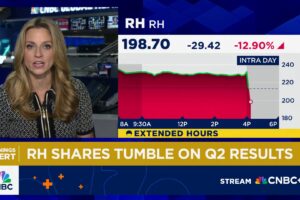We recently compiled a list of the 10 Best Augmented Reality Stocks To Buy Now. In this article, we are going to take a look at where NVIDIA Corporation (NASDAQ:NVDA) stands against the other augmented reality stocks.
Augmented reality (AR) is a technology that enhances our perception of the real world by overlaying digital elements through devices, adding to your existing environment. There are various ways to describe AR, from spatial computing to holographic projection, but its practical applications define its true value. A notable example of an AR device is the HoloLens, a holographic computer that enables users to interact with digital content within the real world, leading to its growing adoption across various industries such as education, manufacturing, and healthcare.
AR/VR Startups
Despite its applications and prospective growth, the AR space seems to have lost favor with venture capitalists, with investments declining due to disappointing adoption rates for the gear and leading metaverse platforms. Even the launch of the Vision Pro headset earlier this year, promoted as a “spatial computing” device, didn’t significantly shift the mood. Reports suggest that demand for the $3,500 device is cooling, prompting the maker to lower its shipment forecast.
Similarly, the investment climate in the startup sector remains cold, with only about $464 million invested this year in seed through growth-stage funding for AR, VR, and metaverse-related companies. This sets 2024 on course to reach the lowest funding total in years. Most startups that raised large financings during the peak in 2021 haven’t secured new rounds since. However, despite the slowdown, some notable deals have still occurred, with the largest AR-related round this year going to Rokid, a maker of augmented reality glasses, which raised $70 million in January. Another notable investment was in Beijing-based Xreal, a mixed-reality glasses maker that positions itself as a more affordable alternative to the Quest and Vision Pro, which raised $60 million in January at a $1 billion valuation.
Most notably, Google recently partnered with augmented reality startup Magic Leap in a strategic technology deal, hinting that the tech giant may be preparing to re-enter the AR and VR market, a space it has mostly left to rivals. Over a decade ago, the search engine giant was a trailblazer in AR. This enthusiasm peaked during a 2012 demo where skydivers used the glasses to live stream a jump onto a building in San Francisco. However, the product faced significant consumer pushback due to its awkward design and privacy concerns.
Augmented Reality Market & Outlook
The global augmented reality market, valued at $32.1 billion in 2022, is projected to grow from $42.85 billion in 2023 to $432.35 billion by 2031, with a compound annual growth rate (CAGR) of 33.5% over the forecast period, according to industry data from SkyQuest.
A significant portion of the market is mobile AR, leveraging the widespread ownership of smartphones, tablets, and other mobile devices. As of this year, it’s projected that there will be 1.7 billion devices capable of supporting mobile AR. Notably, a key advantage mobile AR enjoys is the massive existing smartphone user base. Unlike the steep challenges AR glasses face, mobile AR benefits from “zero-cost” hardware, making its path to adoption relatively smoother. Growth is expected across both enterprise and consumer segments, including digital AR experiences. A well-known example is the 2016 video game Pokémon GO, where players explore their surroundings to find virtual characters on their phones. Additionally, collaborations between key market players and 5G providers to address latency issues are expected to fuel market growth.
Our Methodology
In this article, we reviewed online rankings and ETFs to determine 20 companies operating in the AR space. We then selected the 10 stocks that were the most popular among elite hedge funds. We sourced the hedge fund data from Insider Monkey’s database of 912 hedge funds, as of Q2 2024. Our focus was on companies that produce AR-related hardware, software, or technologies used in developing augmented reality products. However, we also included companies that offer services essential to the AR industry, like semiconductor chips.
At Insider Monkey we are obsessed with the stocks that hedge funds pile into. The reason is simple: our research has shown that we can outperform the market by imitating the top stock picks of the best hedge funds. Our quarterly newsletter’s strategy selects 14 small-cap and large-cap stocks every quarter and has returned 275% since May 2014, beating its benchmark by 150 percentage points (see more details here).

A close-up of a colorful high-end graphics card being plugged in to a gaming computer.
NVIDIA Corporation (NASDAQ:NVDA)
Number of Hedge Fund Holders: 179
NVIDIA Corporation (NASDAQ:NVDA) powers some of the leading AR and VR devices globally. For instance, NVIDIA Cloud RX delivers VR and AR experiences over 5G and Wi-Fi networks, enabling users to stream AR content wirelessly. NVIDIA Corporation (NASDAQ:NVDA) is also advancing technology to integrate AR into vehicles, with its NVIDIA Drive AR processor collecting data and displaying it to drivers through augmented reality.
Citi reaffirmed its Buy rating and $150 price target for NVIDIA Corporation (NASDAQ:NVDA) after the company announced a new service designed to enhance generative AI capabilities for enterprises. The new offering, NVIDIA AI Foundry, in collaboration with NVIDIA NIM inference microservices, leverages Meta’s openly available Llama 3.1 models. Additionally, analysts at Fundstrat Global Advisors predicted that NVIDIA Corporation (NASDAQ:NVDA)’s revenue could increase tenfold, potentially reaching $1 trillion by the end of the decade.
In Q1 2025, NVIDIA Corporation (NASDAQ:NVDA) reported a remarkable revenue of $26.0 billion, reflecting a 262% increase year-over-year. The company’s non-GAAP earnings per diluted share were $6.12, up 461% year-over-year. This impressive performance was largely driven by the Data Center segment, which achieved record revenue of $22.6 billion, representing a 23% increase quarter-over-quarter and a 427% increase year-over-year.
In the second quarter of this year, Insider Monkey’s research indicated that 179 out of 912 hedge funds held investments in NVIDIA Corporation (NASDAQ:NVDA). Among these, Rajiv Jain’s GQG Partners was one of the largest shareholders, with a $9.34 billion investment in the company.
Polen Focus Growth Strategy stated the following regarding NVIDIA Corporation (NASDAQ:NVDA) in its Q2 2024 investor letter:
“In the second quarter, the dominant narrative in markets continued to be generative AI (GenAI). If it wasn’t immediately evident from NVIDIA Corporation’s (NASDAQ:NVDA) meteoric rise to among the largest companies in the world, one need only look so far as the Semiconductor and Technology Hardware industries as a gauge of sentiment, collectively accounting for greater than 70% of the Russell 1000 Growth (“the Index”) and 85% of the S&P 500 headline return quarter to date.
Our Portfolio has no exposure to NVIDIA or other Semiconductor companies currently benefiting from demand for foundational AI Hardware. The largest relative detractors in the quarter were NVIDIA, Apple, and Salesforce.
For the second quarter in a row, NVIDIA represented the top detractor to relative performance as the stock climbed another 37%, bringing the year-to-date return to +150%. As of this writing, NVIDIA is the third largest company in the world, but for a brief moment, it surpassed Microsoft to become the largest company in the world. Yet again, the company delivered blowout results that surpassed already lofty expectations, reinforcing the narrative that NVIDIA is the only obvious “AI winner” due to the amount of revenue it is currently generating.”
Overall NVDA ranks 4th on our list of the best augmented reality stocks to buy. While we acknowledge the potential of NVDA as an investment, our conviction lies in the belief that AI stocks hold greater promise for delivering higher returns, and doing so within a shorter timeframe. If you are looking for an AI stock that is more promising than NVDA but that trades at less than 5 times its earnings, check out our report about the cheapest AI stock.
READ NEXT: $30 Trillion Opportunity: 15 Best Humanoid Robot Stocks to Buy According to Morgan Stanley and Jim Cramer Says NVIDIA ‘Has Become A Wasteland’.
Disclosure: None. This article is originally published at Insider Monkey.



